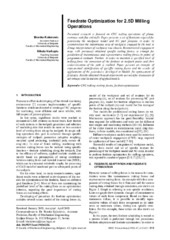Приказ основних података о документу
Optimizacija brzine pomoćnog kretanja u zahvatima 2.5 osnog glodanja
Feedrate optimization for 2.5D milling operations
| dc.creator | Kokotović, Branko | |
| dc.creator | Vorkapić, Nikola | |
| dc.date.accessioned | 2022-09-19T18:45:45Z | |
| dc.date.available | 2022-09-19T18:45:45Z | |
| dc.date.issued | 2019 | |
| dc.identifier.issn | 1451-2092 | |
| dc.identifier.uri | https://machinery.mas.bg.ac.rs/handle/123456789/3092 | |
| dc.description.abstract | Predstavljeno istraživanje se odnosi na CNC obradu glodanjem ravanskih kontura ravnim vretenastim glodalima. U radu je predstavljen skup funkcija, potrebnih za procesiranje modela obratka i tehnološkog programa obrade, sa ciljem rekonstrukcije trenutne površine obratka zahvaćene alatom. Izabrana je interpretacija obratka pomoću Z-mape. Rekonstruisana mapa zahvata, uz prethodno određene specifične sile rezanja, dovoljna je za predviđanje trenutnih i reprezentativnih sila glodanja u tačkama programirane putanje alata. Time se, nadalje, omogućava korigovanje brzina pomoćnog kretanja u tačkama putanje alata i naknadna rediskretizacija te putanje, a sve u cilju održavanja predefinisanog nivoa sile glodanja. U radu je opisan primer eksperimentalne identifikacije specifičnih sila rezanja i primer primene procedura implementiranih u Matlab okruženju, za optimizaciju brzina pomoćnog kretanja. Rezultati, dobijeni u eksperimentu, iskorišćeni su za diskusiju prednosti i nedostataka primenjenih modela. | sr |
| dc.description.abstract | Presented research is focused on CNC milling operations of planar contours with flat end mills. Paper presents a set of functions required for processing the workpiece model and NC part program in order to reconstruction the instantaneous area of workpiece engaged by the tool. A Z-map interpretation of workpiece was chosen. Reconstructed engagement map, with previously obtained specific cutting forces, is enough for prediction of instantaneous and representative milling forces in points of programmed toolpath. Further, in order to maintain a specified level of milling force, the correction of the feedrate in toolpath points and then rediscretization of the path is enabled. Paper presents an example of experimental identification of specific cutting forces and the results of applications of the procedures, developed in Matlab, for optimization of feedrates. Results obtained through experiments are used for discussion of advantages and limitations of applied models. | en |
| dc.publisher | Univerzitet u Beogradu - Mašinski fakultet, Beograd | |
| dc.relation | info:eu-repo/grantAgreement/MESTD/Technological Development (TD or TR)/35022/RS// | |
| dc.rights | openAccess | |
| dc.rights.uri | https://creativecommons.org/licenses/by/4.0/ | |
| dc.source | FME Transactions | |
| dc.subject | feedrate optimization | en |
| dc.subject | cutting forces | en |
| dc.subject | CNC milling | en |
| dc.title | Optimizacija brzine pomoćnog kretanja u zahvatima 2.5 osnog glodanja | sr |
| dc.title | Feedrate optimization for 2.5D milling operations | en |
| dc.type | article | |
| dc.rights.license | BY | |
| dc.citation.epage | 623 | |
| dc.citation.issue | 3 | |
| dc.citation.other | 47(3): 613-623 | |
| dc.citation.rank | M24 | |
| dc.citation.spage | 613 | |
| dc.citation.volume | 47 | |
| dc.identifier.doi | 10.5937/fmet1903613K | |
| dc.identifier.fulltext | http://machinery.mas.bg.ac.rs/bitstream/id/1759/3089.pdf | |
| dc.identifier.scopus | 2-s2.0-85070530147 | |
| dc.identifier.wos | 000465592100026 | |
| dc.type.version | publishedVersion |


